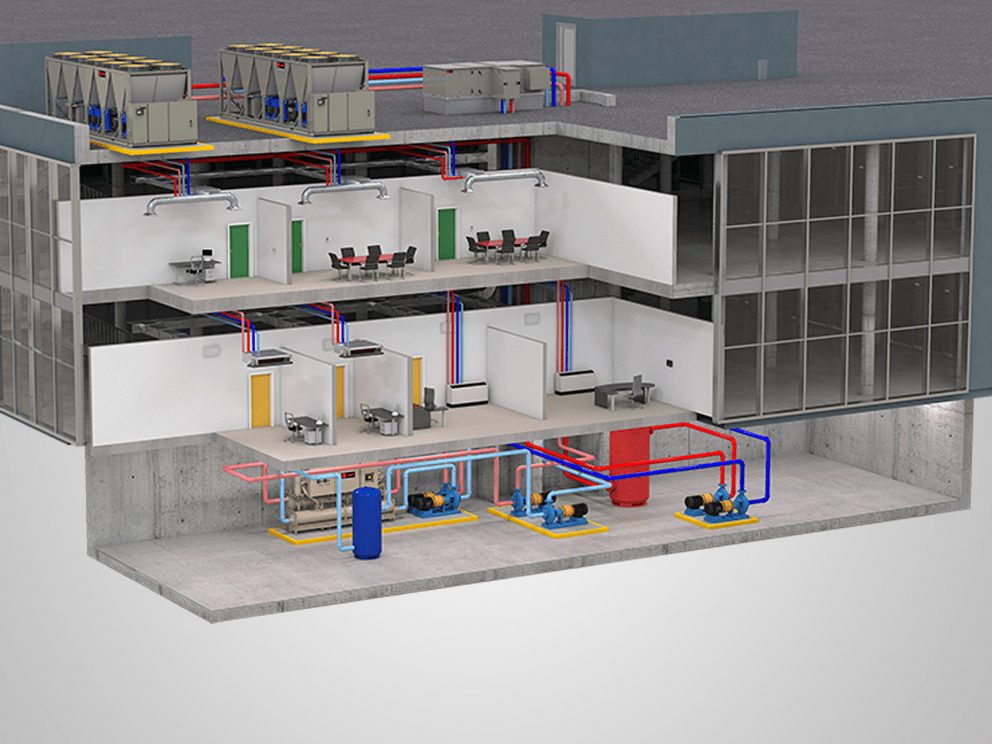Thermal Comfort Solutions
Smart temperature solutions to support your sustainability goals and achieve a more comfortable, productive, energy-efficient building for your occupants.

What is Thermal Comfort?
Thermal comfort measures the degree of satisfaction perceived by the human body as a result of the heating and cooling factors in an environment. For buildings, individual satisfaction can be difficult to achieve because every human perceives temperature differently. Age, season, clothing and even desk location can all impact the way we experience our environment. However, thermal comfort is less about keeping everyone comfortable 24/7 and more about implementing solutions that help you manage temperature and humidity levels more carefully and efficiently. That’s where Trane excels.

What are the Benefits of Improving Thermal Comfort?
Optimizing thermal comfort can impact more than just your people and building systems—it can directly affect your business, too. Here’s how you could benefit from improving your thermal comfort:
- Increase occupant comfort
- Stimulate productivity by up to 10%1
- Protect human wellness
- Generate more purchases from retail customers2
- Maximize energy savings3

Importance of Temperature Control
Trane’s temperature control solutions provide unmatched visibility into your HVAC performance, empowering you with actionable insights to make precise optimizations in real-time. This helps you carefully manage comfort levels to only use the energy you need. In addition, Trane’s integrated system controls allow you to delegate HVAC management to numerous users, including enterprise managers, building managers, and even individual tenants.

Understanding the Causes of Discomfort
When your occupants are uncomfortable, you feel it in a number of ways. They might tell you if it’s too hot or too cold, but over time it could rear its head in your bottom line. In fact, multiple studies have shown that the more comfortable people are, the more productive they become.4 The reason for discomfort in your building is likely unique to you, and identifying the root cause is the first step to resolving it. Trane has a deep expertise in the dynamics between buildings, systems and people, and we follow a proven 3-step process to help you understand what’s happening inside your walls.

How do you Monitor Thermal Comfort?
Consistently monitoring your indoor temperature is critical to sustain a healthy, comfortable space. That’s why Trane offers personalized thermal and humidity management solutions to optimize performance according to your needs. In addition, our integrated system controls let you empower building managers, tenants and other stakeholders with real-time monitoring access to proactively manage comfort levels and consume energy more efficiently.
How Trane Experts Help With Temperature Control
Effective temperature control and humidity management looks different for every building. Trane uses a unique 3-step process to assess your existing systems and deliver customized strategies to mitigate your current challenges and manage performance long-term. From advanced HVAC systems and equipment to integrated controls and monitoring, our holistic portfolio of thermal comfort solutions has everything you need to optimize comfort and maintain efficiency with confidence.
Optimize my Thermal Comfort with Trane
1 Quantitative measurement of productivity loss due to thermal discomfort, THERMAL COMFORT AND PRODUCTIVITY, Effect of temperature on task performance in office environment, How Indoor Environment Affects Performance
2 The effects of store atmosphere on shopping behavior-a literature review.& The Effects of Store Environment on Shopping Behaviors: a Critical Review
3 Artificial Intelligence for Efficient Thermal Comfort Systems: Requirements, Current Applications and Future Directions
4 “Indoor Climate and Productivity in Offices”. Vol. 6. REHVA Guidebooks 6. Brussels, Belgium: REHVA 2006. And “Effects of Moderate Heat Stress on Mental Performance”, Studies in Environmental Science, Elsevier, 5 (4), pp. 251–267, 1981.

































































































